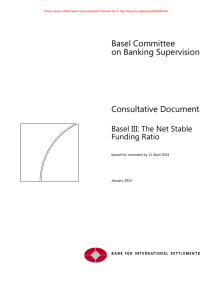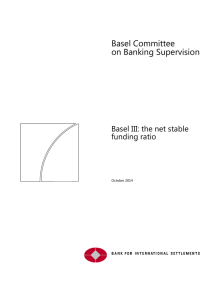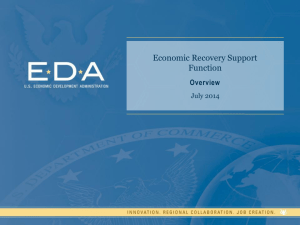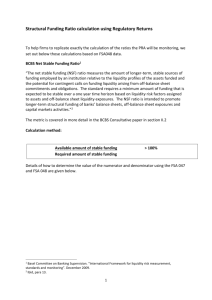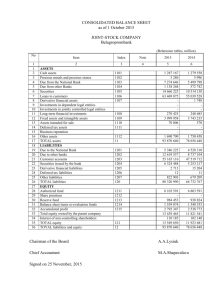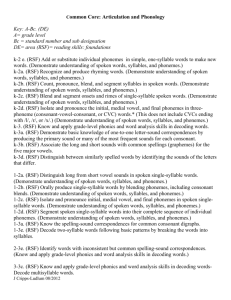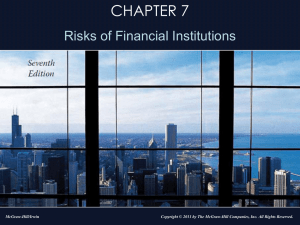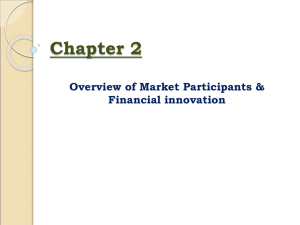Basel III Framework: The Net Stable Funding Ratio
advertisement
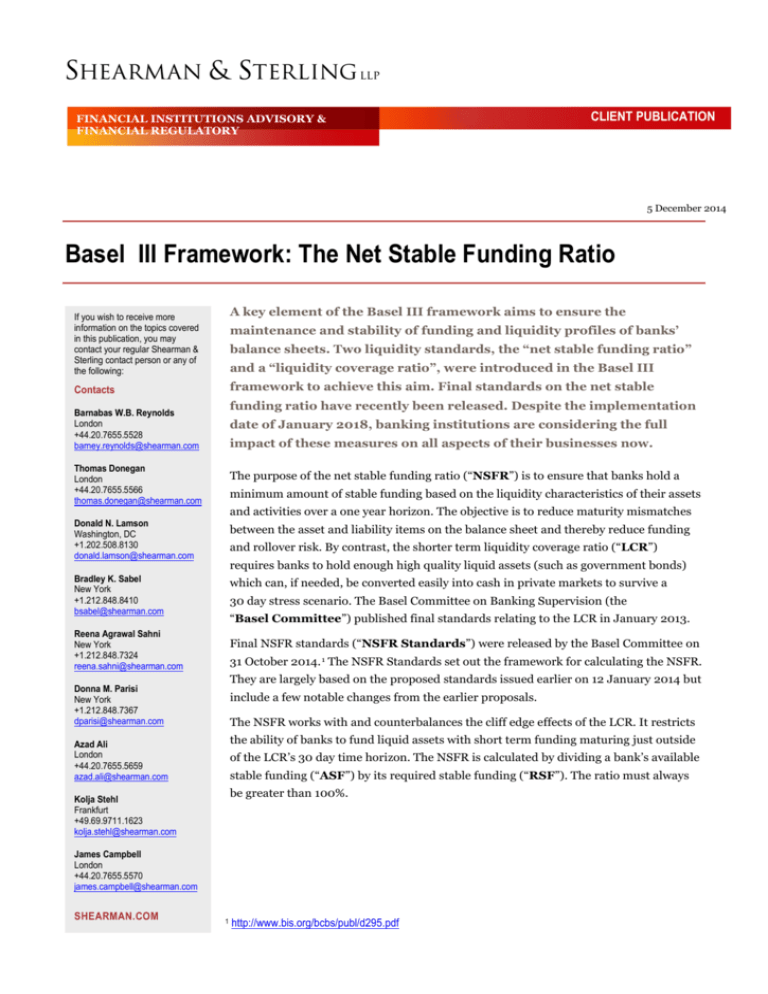
FINANCIAL INSTITUTIONS ADVISORY & FINANCIAL REGULATORY CLIENT PUBLICATION 5 December 2014 Basel III Framework: The Net Stable Funding Ratio A key element of the Basel III framework aims to ensure the If you wish to receive more information on the topics covered in this publication, you may contact your regular Shearman & Sterling contact person or any of the following: maintenance and stability of funding and liquidity profiles of banks’ balance sheets. Two liquidity standards, the “net stable funding ratio” and a “liquidity coverage ratio”, were introduced in the Basel III framework to achieve this aim. Final standards on the net stable Contacts funding ratio have recently been released. Despite the implementation Barnabas W.B. Reynolds London +44.20.7655.5528 barney.reynolds@shearman.com date of January 2018, banking institutions are considering the full impact of these measures on all aspects of their businesses now. Thomas Donegan London +44.20.7655.5566 thomas.donegan@shearman.com The purpose of the net stable funding ratio (“NSFR”) is to ensure that banks hold a minimum amount of stable funding based on the liquidity characteristics of their assets and activities over a one year horizon. The objective is to reduce maturity mismatches Donald N. Lamson Washington, DC +1.202.508.8130 donald.lamson@shearman.com between the asset and liability items on the balance sheet and thereby reduce funding and rollover risk. By contrast, the shorter term liquidity coverage ratio (“LCR”) requires banks to hold enough high quality liquid assets (such as government bonds) Bradley K. Sabel New York +1.212.848.8410 bsabel@shearman.com which can, if needed, be converted easily into cash in private markets to survive a 30 day stress scenario. The Basel Committee on Banking Supervision (the “Basel Committee”) published final standards relating to the LCR in January 2013. Reena Agrawal Sahni New York +1.212.848.7324 reena.sahni@shearman.com Final NSFR standards (“NSFR Standards”) were released by the Basel Committee on 31 October 2014. 1 The NSFR Standards set out the framework for calculating the NSFR. They are largely based on the proposed standards issued earlier on 12 January 2014 but Donna M. Parisi New York +1.212.848.7367 dparisi@shearman.com include a few notable changes from the earlier proposals. The NSFR works with and counterbalances the cliff edge effects of the LCR. It restricts the ability of banks to fund liquid assets with short term funding maturing just outside Azad Ali London +44.20.7655.5659 azad.ali@shearman.com of the LCR’s 30 day time horizon. The NSFR is calculated by dividing a bank’s available stable funding (“ASF”) by its required stable funding (“RSF”). The ratio must always be greater than 100%. Kolja Stehl Frankfurt +49.69.9711.1623 kolja.stehl@shearman.com James Campbell London +44.20.7655.5570 james.campbell@shearman.com SHEARMAN.COM 1 http://www.bis.org/bcbs/publ/d295.pdf Multipliers are applied to designated RSF and ASF items to reflect the degree of stability of liabilities and the varying liquidity of assets. The ASF measure (the “ASF Factor”) broadly regards the most stable sources of funding to be regulatory capital, deposits and funding maturing beyond a year. The RSF measure (the “RSF Factor”) grades various assets in terms of the proportion of stable funding required to support them. For example, loans to financial institutions, assets that are encumbered for a period of one year or more, net amounts receivable under derivative trades, non-performing loans, fixed assets, and non-exchange traded equities require matched stable funding. Residential mortgages would require stable funding in the order of 65% of the mortgage amount. Further, certain short-dated assets maturing in less than one year require a smaller proportion of stable funding as banks may allow some proportion of those assets to mature instead of rolling them over. The NSFR also factors in “asset quality” and “liquidity value,” recognising that some assets do not require full financing by stable funding where they are securitisable or tradable to secure additional funding. Off-balance sheet commitments and contingent liabilities which create potential calls on liquidity also require stable funding. There is a limited carve-out for “interdependent” assets and liabilities, but this is subject to national supervisory discretion. It is relevant where, pursuant to contractual arrangements, settlement of a liability is only triggered once an asset is repaid. The asset and counterparty liability in these circumstances are excluded from the NSFR calculation, but subject further to the following criteria: I. the individual interdependent asset and liability items are clearly identifiable; II. the maturity and principal amount of both the liability and its interdependent asset is the same; III. the liability cannot fall due while the asset remains on the balance sheet; IV. the principal payment flows from the asset cannot be used for any purpose except repaying the liability; V. the bank acts as a pass-through to channel funding received (the interdependent liability) to the interdependent asset; VI. the counterparties for each pair of interdependent liabilities and assets are not the same; and VII. the liability cannot be used to fund other assets. National supervisors may adjust ASF and RSF Factors so that interdependent assets and liabilities are ascribed a multiplier of 0%, subject to safeguarding against perverse incentives or unintended consequences. Further, the use of the discretion must be clearly and explicitly defined to provide clarity both within the jurisdiction and internationally. This exemption from the NSFR is very narrowly prescribed and it is not clear how useful it would be in practice (although it would serve to exempt exposures that banks have to clients when acting in the capacity of a clearing member clearing client-originated trades where there is no guarantee of clearing house performance). Off-balance sheet or contingent exposures (“OBS Exposures”) are also assigned an RSF Factor given the potential funding needs over a prolonged time horizon. Different RSF Factors are assigned to different types of OBS Exposures. The NSFR Standards treat derivative liabilities quite stringently. Net derivative assets are ascribed a 100% RSF Factor and net derivative liabilities are ascribed a 0% ASF Factor. In addition, 20% of net derivative liabilities (where there is a negative replacement cost associated) is given a 100% RSF Factor. 2 A summary of the NSFR and its components is set out in the Annex to this Client Publication. Key Impacts I. Effect on repo market: Quite concerted lobbying efforts by the industry managed to achieve a more lenient NSFR outcome for repo trades. The previous proposed standards created an asymmetry between repo trades (for trades with non-banks) where, as cash lender, the exposure attracted a 50% RSF Factor. A corresponding trade where the bank acts as cash borrower did not attract a corresponding ASF Factor. Given the added impact of the leverage ratio on repo exposures, significant concern was expressed about the increase in the capital and funding required for such trades and the consequent effect on the repo market and liquidity for government debt and other fixed income securities. The final NSFR Standards have now reduced the RSF Factor to 10% although it is 15% if the securities borrowed are not capable of being rehypothecated. Further relief may potentially be afforded by the exemption for interdependent assets and liabilities. That said, there are increasing calls for central clearing of repo trades which would reduce the balance sheet impact caused by the NSFR. II. Effect on equity transactions: Exchange-traded equities, if issued by a non-financial institution, attract a 50% RSF Factor, implying that 50% of such equity holdings are assumed to take a year to monetise and 50% of such holdings are liquid. This effectively applies a significant funding and liquidity stress to equity positions. For trades that are effectively hedges or linked transactions, the exemption for interdependent assets and liabilities would be difficult to apply given that one of the criteria for applying the exemption relies on the asset and matching liability to have the same maturity and principal amount. Cash-equity trades do not have any explicit maturity. III. Short term compliance costs: While the NSFR does not come into force until January 2018, market pressure among peers is causing banks to adjust their funding profile to meet basic NSFR requirements ahead of schedule and, often at significant cost. Compliance is likely to be particularly challenging in jurisdictions with relatively small retail deposit markets, therefore taking away a significant potential source of long-term stable funding. IV. “Chilling effect” on long term lending: Many significant players in long term lending markets, such as in aircraft finance, shipping finance and project finance markets, have announced an intention to reduce operations in this area due to increased costs as a result of the NSFR. Liquidity profiles are often adversely impacted by long term, illiquid debt. In project finance, for example, banks who continue to lend in the sector often wish to ensure that loan facilities are transferable without borrower consent, and that transactions are structured to take into account liquidity requirements. As a result of the NSFR, loan tenors have significantly shortened. It is also becoming increasingly common to enter into “mini perm” facilities, which assume a repayment of debt after a limited period of time (typically, five to seven years) through refinancing, but with an amortisation profile extending beyond maturity. Other solutions and trends are likely to emerge as a result of the NSFR. The impact on long term lending may be abated somewhat by the entry of new lenders into the market (including “shadow-banking” entities), filling the gap left by those who have had to curtail their lending activity as a result of the NSFR. V. Opportunities for arbitrage: Legal implementation of the NSFR is likely to differ between countries. The Basel Committee recognises that certain national discretions may be permitted subject to these being explicitly and clearly outlined in local rules. Within the EU, the Capital Requirements Regulation 2 permits certain national divergences. The extent to which EU Member States will use these discretions is currently unclear. For example, 2 Regulation (EU) 575/2013 on prudential requirements for credit institutions and investment firms and amending Regulation (EU) No 648/2012. 3 the NSFR Standards state that in the calibration of off balance sheet assets, national supervisors are free to specify the relevant weightings for a broad range of products and instruments including: (i) unconditionally revocable credit and liquidity facilities; (ii) trade finance related obligations (including guarantees and letters of credit); and (iii) certain non-contractual obligations such as potential requests for debt repurchases of the bank’s own debt, and managed funds that are marketed with the objective of maintaining a stable value. VI. Burdens for clearing firms: Clearing firms may face increased costs as a result of the requirement to secure stable funding for initial margin for derivatives trades or contributions to the default fund of a clearing house. Clearing firms may need to alter their fees structures in response. Notably, where assets provided as initial margin for derivative contracts would have otherwise received a higher RSF Factor, then that higher factor applies. The NSFR Standards do not represent a radical departure from the previous consultation paper and the industry will continue to express concern over costs and reappraise the viability of certain business lines. 4 Annex: ASF and RSF Calibration I. Available Stable Funding: ASF is the portion of capital and liabilities of an institution that is expected to be reliable over a one year horizon. The ASF is calculated by the following method: 1. assigning the carrying value of an institution’s capital and liabilities (i.e., the amount at which a liability or equity instrument is recorded before any regulatory deductions, filters or other adjustments) to an “ASF Category;” 2. the amount assigned to each category is then multiplied by the required ASF Factor; and 3. the total ASF is the sum of the weighted amounts. ASF FACTOR ASF CATEGORY 100% Total regulatory capital (excluding Tier 2 instruments with residual maturity of less than one year). Other capital instruments and liabilities with effective residual maturity of one year or more. 95% Stable non-maturity (demand) deposits and term deposits with residual maturity of less than one year provided by retail and small business customers. 90% Less stable non-maturity deposits and term deposits with residual maturity of less than one year provided by retail and small business customers. 50% Funding with residual maturity of less than one year provided by non-financial corporate customers. Operational deposits. Funding with residual maturity of less than one year from sovereigns, public sector entities and multilateral and national development banks. Other funding with residual maturity between six months and less than one year not included in the above categories, including funding provided by central banks and financial institutions. 0% All other liabilities and equity not included in the above categories, including liabilities without a stated maturity (with a specific treatment for deferred tax liabilities and minority interests). NSFR derivative liabilities net of NSFR derivative assets if NSFR derivative liabilities are greater than NSFR derivative assets. “Trade date” payables arising from purchases of financial instruments, foreign currencies and commodities. Differences from the NSFR Consultation Paper Tier 2 instruments with residual maturity of less than one year are excluded from the 100% ASF Category. Deferred tax liabilities and minority interests in the 0% ASF Category are subject to specific treatment. Net NSFR derivative liabilities are included in the 0% ASF Category. “Trade date” payables are included in the 0% ASF Category. 5 II. Required Stable Funding: The RSF is a function of the liquidity characteristics and residual maturities of the various assets held by that institution, as well as its off balance sheet exposures. The RSF is calculated by the following method: 1. assigning the carrying value of an institution’s capital and liabilities to an “RSF Category” based on their residual maturity or liquidity value; 2. the amount assigned to each category is then multiplied by the required RSF Factor; and 3. the total RSF is the sum of the weighted amounts added to the amount of off balance sheet activity (or potential liquidity exposure) multiplied by its associated RSF Factor. RSF FACTOR RSF CATEGORY 0% Coins and banknotes. All central bank reserves. All claims on central banks with residual maturities of less than six months. “Trade date” receivables arising from sales of financial instruments, foreign currencies and commodities. 5% Unencumbered Level 1 assets, excluding coins, banknotes and central bank reserves. 10% Unencumbered loans to financial institutions with residual maturities of less than six months, where the loan is secured against Level 1 assets (“High Quality Liquid Assets” or “HQLA”) and where the bank has the ability to freely rehypothecate the received collateral for the life of the loan. 15% All other unencumbered loans to financial institutions with residual maturities of less than six months not included in the above categories. Unencumbered Level 2A assets. 50% Unencumbered Level 2B assets. HQLA encumbered for a period of six months or more and less than one year. Loans to financial institutions and central banks with residual maturities between six months and less than one year. Deposits held at other financial institutions for operational purposes. All other assets not included in the above categories with residual maturity of less than one year, including, loans to non-financial corporate clients, loans to retail and small business customers, and loans to sovereigns, and public sector entities. 65% Unencumbered residential mortgages with a residual maturity of one year or more and with a risk weight of less than or equal to 35% under the Standardised Approach to credit risk. Other unencumbered loans not included in the above categories, excluding loans to financial institutions, with a residual maturity of one year or more and with a risk weight of less than or equal to 35% under the Standardised Approach. 85% Cash, securities or other assets posted as initial margin for derivative contracts and cash or other assets provided as contributions to the default fund of a clearing house. Other unencumbered performing loans with risk weights greater than 35% under the Standardised Approach and residual maturities of one year or more, excluding loans to financial institutions. Unencumbered securities that are not in default and do not qualify as HQLA with a remaining maturity of one year or more and exchange-traded equities. Physical traded commodities, including gold. 6 RSF FACTOR RSF CATEGORY 100% All assets that are encumbered for a period of one year or more. NSFR derivative assets net of NSFR derivative liabilities if NSFR derivative assets are greater than NSFR derivative liabilities. 20% of derivative liabilities, as calculated according to paragraph 19 NSFR Standards. All other assets not included in the above categories, including non-performing loans, loans to financial institutions with a residual maturity of one year or more, non-exchange traded equities, fixed assets, items deducted from regulatory capital, retained interest, insurance assets, subsidiary interests and defaulted securities. Differences from the NSFR Consultation Paper The 0% RSF Category includes claims on central banks with residual maturities of less than six months. Addition of “trade date” receivables arising from sales of financial instruments, foreign currencies and commodities to the 0% RSF Category. Addition of a 10% RSF Category for certain unencumbered loans to financial institutions maturing within 6 months. All other unencumbered loans not within the 10% RSF Category will fall into the 15% RSF Category. Unencumbered loans to financial institutions with residual maturities of less than six months were previously ascribed a 0% RSF Factor. Cash, securities or other assets posted as initial margin for derivative contracts or contributed to the default fund of a clearing house are included in the 85% RSF Category. Unencumbered securities that are not in default and do not qualify as HQLA with a remaining maturity of one year or more are included in the 85% RSF Category. Addition of 20% of derivative liabilities in the 100% RSF Category. ABU DHABI | BEIJING | BRUSSELS | FRANKFURT | HONG KONG | LONDON | MILAN | NEW YORK | PALO ALTO PARIS | ROME | SAN FRANCISCO | SÃO PAULO | SHANGHAI | SINGAPORE | TOKYO | TORONTO | WASHINGTON, DC This memorandum is intended only as a general discussion of these issues. It should not be regarded as legal advice. We would be pleased to provide additional details or advice about specific situations if desired. 6 APPOLD STREET | LONDON | EC2A 2AP Copyright © 2014 Shearman & Sterling LLP. Shearman & Sterling LLP is a limited liability partnership organized under the laws of the State of Delaware, with an affiliated limited liability partnership organized for the practice of law in the United Kingdom and Italy and an affiliated partnership organized for the practice of law in Hong Kong. 7
